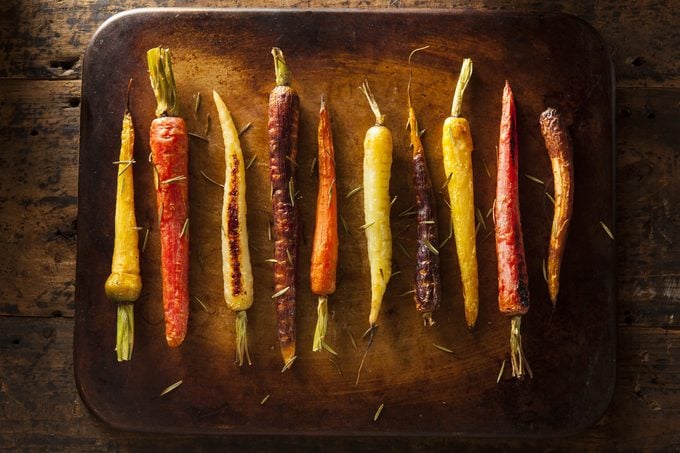Rib Roast Cooking Times Chart
 Brent Hofacker/Shutterstock
Brent Hofacker/Shutterstock
This is the perfect way to promote healthy eating! It doesn't matter if you're looking for a meatless Monday meal or a quick and easy way to throw lunch together; having a handful of roasted veggies on hand always does the trick. Eat them with rice or quinoa for a healthy bowl, use them as a pizza topping, or wrap 'em up into a burrito. Once you know how to roast vegetables, they can become a go-to powerhouse for meal prepping. The best part: you don't need a recipe to make them. Try roasting some of the healthiest veggies you can eat.
There are very few rules when it comes to roasting vegetables. You can roast almost anything in the crisper drawer (except perhaps those tender lettuces) and every type of root vegetable. Once you've chosen your veggie, use this guide as a reference to achieve perfectly crispy results, every time.
Slice and dice
Trimming your vegetables down to size not only increases their surface area (creating more space for caramelization), but it also determines how quickly everything roasts. The smaller the cut, the faster it cooks—which means you'll need to keep a careful eye on small-diced vegetables so they don't turn out mushy.
No matter what cut you settle on—thin slices or thick chunks—remember that food cooks more uniformly when it's cut into similar shapes. This is especially important to keep in mind if you're mixing multiple vegetable varieties onto one sheet pan. Don't be afraid to roast heartier vegetables like potatoes and butternut squash separately from more tender veggies like zucchini or broccoli.
Don't forget the oil
No matter how you choose to season your vegetables—a fancy marinades or just a few fresh herbs and some salt—don't forget to coat them with oil. It really doesn't matter if you choose olive oil, lard, coconut oil, or any other type with a high smoke point. One or two tablespoons of this all-important fat will help everything caramelize while also adding flavor to your veggies. Add roasted veggies to the list of ways to eat more vegetables without even trying.
Avoid overcrowding the pan
If everything is crammed together on the sheet pan, your vegetables will lacklusterly steam instead of browning and caramelizing. Steam is the enemy of searing, so give your vegetables enough space to breathe. That may mean using two sheet pans if you're feeding a crowd or prepping for the week, but it's totally worth it when you end up with nice, crispy edges.
Roast 'em right
OK, now we're getting into the nitty gritty of it. In general, you want to roast vegetables until they're fork tender and have caramelized edges. We prefer high-temperature roasting at 400°F to 425°F. This method quickly coaxes out the vegetable's naturally sweet flavors and promotes the best caramelization.
Here's a baseline for how long to each vegetable. Just remember: the smaller you cut your vegetables, the shorter the cooking time.
- Green beans, asparagus, and other thin vegetables: 10-20 minutes
- Bell peppers, zucchini, tomatoes, summer squash, and other soft vegetables: 10-25 minutes
- Cabbage, broccoli, cauliflower, Brussels sprouts, and other crucifers: 15-25 minutes
- Potatoes, onions, beets, carrots, winter squash, and other root vegetables: 30-45 minutes
If it's too hot outside to turn the oven up that high, turn to the grill instead! Check out our favorite ways to grill vegetables, including some tips and tricks to help you become a pro. Then be sure not to make these 25 cooking mistakes that ruin your food.
Rib Roast Cooking Times Chart
Source: https://www.rd.com/article/how-to-roast-vegetables/
Posted by: gossstrable.blogspot.com

0 Response to "Rib Roast Cooking Times Chart"
Post a Comment